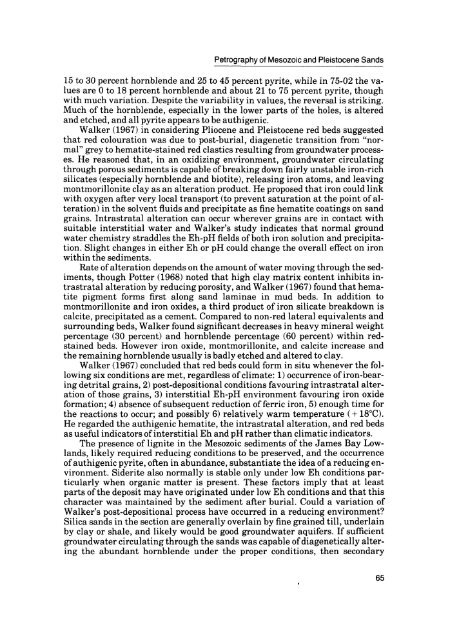Moose River Basin: geology and mineral potential - Geology Ontario
Moose River Basin: geology and mineral potential - Geology Ontario
Moose River Basin: geology and mineral potential - Geology Ontario
Create successful ePaper yourself
Turn your PDF publications into a flip-book with our unique Google optimized e-Paper software.
Petrography of Mesozoic <strong>and</strong> Pleistocene S<strong>and</strong>s<br />
15 to 30 percent hornblende <strong>and</strong> 25 to 45 percent pyrite, while in 75-02 the va<br />
lues are O to 18 percent hornblende <strong>and</strong> about 21 to 75 percent pyrite, though<br />
with much variation. Despite the variability in values, the reversal is striking.<br />
Much of the hornblende, especially in the lower parts of the holes, is altered<br />
<strong>and</strong> etched, <strong>and</strong> all pyrite appears to be authigenic.<br />
Walker (1967) in considering Pliocene <strong>and</strong> Pleistocene red beds suggested<br />
that red colouration was due to post-burial, diagenetic transition from "nor<br />
mal" grey to hematite-stained red elastics resulting from groundwater process<br />
es. He reasoned that, in an oxidizing environment, groundwater circulating<br />
through porous sediments is capable of breaking down fairly unstable iron-rich<br />
silicates (especially hornblende <strong>and</strong> biotite), releasing iron atoms, <strong>and</strong> leaving<br />
montmorillonite clay as an alteration product. He proposed that iron could link<br />
with oxygen after very local transport (to prevent saturation at the point of al<br />
teration) in the solvent fluids <strong>and</strong> precipitate as fine hematite coatings on s<strong>and</strong><br />
grains. Intrastratal alteration can occur wherever grains are in contact with<br />
suitable interstitial water <strong>and</strong> Walker's study indicates that normal ground<br />
water chemistry straddles the Eh-pH fields of both iron solution <strong>and</strong> precipita<br />
tion. Slight changes in either Eh or pH could change the overall effect on iron<br />
within the sediments.<br />
Rate of alteration depends on the amount of water moving through the sed<br />
iments, though Potter (1968) noted that high clay matrix content inhibits in<br />
trastratal alteration by reducing porosity, <strong>and</strong> Walker (1967) found that hema<br />
tite pigment forms first along s<strong>and</strong> laminae in mud beds. In addition to<br />
montmorillonite <strong>and</strong> iron oxides, a third product of iron silicate breakdown is<br />
calcite, precipitated as a cement. Compared to non-red lateral equivalents <strong>and</strong><br />
surrounding beds, Walker found significant decreases in heavy <strong>mineral</strong> weight<br />
percentage (30 percent) <strong>and</strong> hornblende percentage (60 percent) within redstained<br />
beds. However iron oxide, montmorillonite, <strong>and</strong> calcite increase <strong>and</strong><br />
the remaining hornblende usually is badly etched <strong>and</strong> altered to clay.<br />
Walker (1967) concluded that red beds could form in situ whenever the fol<br />
lowing six conditions are met, regardless of climate: 1) occurrence of iron-bear<br />
ing detrital grains, 2) post-depositional conditions favouring intrastratal alter<br />
ation of those grains, 3) interstitial Eh-pH environment favouring iron oxide<br />
formation; 4) absence of subsequent reduction of ferrie iron, 5) enough time for<br />
the reactions to occur; <strong>and</strong> possibly 6) relatively warm temperature (+ 18 0C).<br />
He regarded the authigenic hematite, the intrastratal alteration, <strong>and</strong> red beds<br />
as useful indicators of interstitial Eh <strong>and</strong> pH rather than climatic indicators.<br />
The presence of lignite in the Mesozoic sediments of the James Bay Low<br />
l<strong>and</strong>s, likely required reducing conditions to be preserved, <strong>and</strong> the occurrence<br />
of authigenic pyrite, often in abundance, substantiate the idea of a reducing en<br />
vironment. Siderite also normally is stable only under low Eh conditions par<br />
ticularly when organic matter is present. These factors imply that at least<br />
parts of the deposit may have originated under low Eh conditions <strong>and</strong> that this<br />
character was maintained by the sediment after burial. Could a variation of<br />
Walker's post-depositional process have occurred in a reducing environment?<br />
Silica s<strong>and</strong>s in the section are generally overlain by fine grained till, underlain<br />
by clay or shale, <strong>and</strong> likely would be good groundwater aquifers. If sufficient<br />
groundwater circulating through the s<strong>and</strong>s was capable of diagenetically alter<br />
ing the abundant hornblende under the proper conditions, then secondary<br />
65

















